Brazilian Army
| Brazilian Army Exército Brasileiro | |
|---|---|
|
Brazilian Army Seal | |
| Active | 1822–present |
| Country |
|
| Branch | Army |
| Size |
219,663 active (2014)[1][2][3] 1,340,000 reserve (2014)[1] |
| Part of | Ministry of Defence |
| Command Headquarters | Brasília, DF |
| Patron | Duke of Caxias |
| Motto |
Braço Forte, Mão Amiga (English: "Strong arm, friendly hand!") |
| Colors | Olive Green |
| March |
Canção do Exército (English: "Song of the Army") |
| Mascot | Jaguar |
| Anniversaries |
August 25 (Soldier's Day) April 19 (Brazilian Army Day) |
| Equipment |
469 Main battle tanks 1,496 armored vehicles 1,257 artillery pieces 184 Self-propelled artillery 156 SAM systems ~20,000 Support vehicles 90 helicopters |
| Engagements |
|
| Commanders | |
| Commander-in-Chief | President Dilma Rousseff |
| Commander | General Eduardo Villas Bôas |
| Notable commanders | |
The Brazilian Army (Portuguese: Exército Brasileiro) is the land arm of the Brazilian Armed Forces. The Brazilian Army has fought in several international conflicts, mostly in South America during the 19th century. In the 20th century, it fought on the Allied side at World War I and World War II. Aligned with Western Bloc, it also had active participation in the Cold War, in Latin America and Southern Portuguese Africa, as well as taking part in UN peacekeeping missions worldwide since the late 1950s.
Domestically, besides having faced several rebellions throughout these two centuries, with support of key local elites and the big international capital, it also ended the monarchy and imposed on the rest of society its political views and economic development projects during the periods (1889–94, 1930–50* and 1964–85) that it ruled the country.
* First Vargas period and Dutra years
History
Origins
- Main Articles: 1st French-Portuguese colonial war, 2nd French-Portuguese colonial war, Sugar War, French raids (1710–11), Napoleonic Wars in South America and Possession Conflicts for Banda Oriental
Although the Brazilian Army was created during the process of the independence of Brazil from Portugal, in 1822, with the units of the Portuguese Army in Brazil that have remained loyal to Prince Dom Pedro, its origins can date back to Land Forces used by Portuguese in the colonial wars against French and Dutch, fought in 16th and 17th centuries. During the Independence process, the Army was initially composed of Brazilians, Portuguese and foreign mercenaries. Most of its commanders were mercenaries and Portuguese officers loyal to Dom Pedro.
Along 1822 and 1823, the Brazilian Army was able to defeat the Portuguese resistance, especially in the north of country and in Cisplatina, having also avoided a fragmentation of the then new Brazilian Empire after its independence war.
19th century
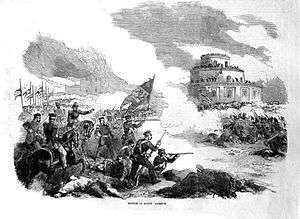
- Main Articles: Brazilian Independence War, Confederation of the Equator, Cisplatine War, Ragamuffin War, Cabanagem Rebellion, Balaiada Revolt, Platine War, Uruguayan War, Paraguayan War, Naval Revolts, Federalist Rebellion and War of Canudos
The National Army, or Imperial Army during the monarchy, was divided into two branches: the 1st Line, which was the Army itself; and the 2nd Line, which was formed by the Militias and Orderlies inherited from the colonial times. When the Portuguese military in the provinces of the Bahia, Maranhão, Pará and Cisplatine refused to join the Independence cause, Emperor Pedro I reorganized the troops at his disposal for the imminent conflict. Most of the personnel stationed in the country remained loyal to the monarch, who made use of troops, equipment and forts for the war operations. The terrestrial force efficiently fought in the north and the south of Brazil, defeating the loyal troops of Portugal. In 1824 the Army of the 1st Line included 24,000 men,[4] who were disciplined, trained and equipped just as well as European equivalents.[5] At the end of the war of Independence, the Brazilian Armed Forces were already well organized and equipped.[6] This occurred mainly because Pedro I heavily supported the Army.[7] In the same year a battalion was sent to Pernambuco where it successfully quelled the revolt of the Confederation of the Equator.[8]
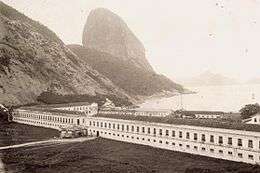
Army officers' training was completed in the Military Academy (now Academia Militar de Agulhas Negras, also the only engineering school in Brazil up to 1874),[9] although it was not obligatory for personnel to study there to advance in the profession.[10] Personnel from the infantry and cavalry branches only needed to study the disciplines of the 1st year (arithmetic, algebra, geometry, trigonometry and technical drawing) and 5th year (tactical, strategy, camping, fortification in campaign, terrain reconnaissance and chemistry). Engineers and artillerymen were obliged to study the complete course, which resulted in their branches being considered the most prestigious. However, if they preferred, infantrymen and cavalrymen were allowed to study the disciplines of the 2nd year (algebra, geometry, analytical geometry, differential and integral calculus, descriptive geometry and technical drawing); 3rd year (mechanics, ballistics and technical drawing); 4th year (spherical trigonometry, physics, astronomy, geodesy, geography and technical drawing); 6th year (regular and irregular fortification, attacking and defending strongholds, civil architecture, roads, ports, canals, mineralogy and technical drawing); and 7th year (artillery, mines and natural history).[11]
After the Brazilian Army won the Independence War, the Army supported by the National Guard (a paramilitary militia created in 1831 by the big owners of slave and land, known as "Colonels"), destroyed any separatist tendencies of the early years, enforcing central authority of the empire, during the Regency period in the country, repressing across Brazil a host of popular movements for political autonomy or against slavery and the colonels' power.
Pedro I's abdication resulted in the reduction of the size of the Army contingent.[12] The liberals were against the Army for ideological and economic reasons.[13] Their objective was to prevent any possibility of return to Brazil by Pedro I, so they weakened one of the institutions most connected to the former Emperor.[14] Some battalions were dissolved while others were transferred to distant provinces. Most of the soldiers were discharged; enlistment was suspended and the promotion of any officer was forbidden.[15] On 30 August 1831, the liberal regency reduced the Army to fewer than 10,000 men.[15] Later reductions left only 6,000 soldiers.[16] The battalions formed by mercenaries were also disbanded.[6]

With the intention of assisting the smaller Army, the Government created the National Guard on 18 August 1831.[17] The new institution would substitute for the old Militias and Orderlies that were extinguished at the same time.[12][18] The National Guard was composed of all male Brazilians who had an annual income superior to Rs200$000 (the same value as an elector). The majority of the male population had to meet certain conditions to be part of the National Guard: someone who worked as a craftsman or clerk satisfied the minimum requirements.[19] Even the “ingenuous” (free children of slaves or ex-slaves) were allowed to enlist in the force.[20] The Guard's members were not remunerated and, except for weapons which the Government supplied, the members had to pay all expenses related to uniforms and equipment.[18] However, the Guard's members had little if any military skill and they were completely inadequate for the wars of the Industrial Age.[21] The Guard did not have permanent troops nor barracks for lodging troops. In war times the National Guard was incorporated into the Army of 1st Line and it was, for all effects, a reserve force of the Imperial Army.[22]
The results of the Liberal's policy towards the Army were soon felt. The Government was incapable of fighting the rebellions that occurred in the country during the second half of the 1830s. The election of the conservative Pedro de Araújo Lima for the office of regent in 1837 completely changed the situation. The Conservative Party restored the Army,[6] reorganized and reequipped its ranks, and increased its size to 18,000 men.[16] The Imperial Army achieved several victories over the provincial revolts, including: Cabanagem, Sabinada, Ragamuffin War, among others. At the beginning of the 1840s a new reorganization of the Army gave it more cohesion and made it more capable.[6]
In 1845 the Military College (originally known as the Military Academy) was divided into two-halves: one half retained the name "Military College" and the other half became the Central College.[6] A new reform (Decree nº 585) on 6 September 1850, considerably improved the quality of the officers of the Imperial Army.[23][24] From then on, progression in a soldier's military career would occur through antiquity, merit and academic resume, beyond a clear preference for the personnel who completed the Military College over the ones who did not.[25] On 20 September 1851, the conservative cabinet created a branch of the Military College in Porto Alegre. The Porto Alegre college location provided courses in infantry and cavalry, including disciplines taken from the 1st and 5th years of study.[25] The National Guard was reorganized in the same month and became subordinate directly to the Minister of Justice, instead of to the locally elected Judges of Peace.[26] In 1851 the Imperial Army was composed of more than 37,000[4] men and participated in the Platine War, in which it defeated the Argentine Confederation with the contribution of Uruguayan troops and Argentine rebels.[27]


The Uruguayan War (which was followed by the Paraguayan War) revealed the complete neglect subjected on the Imperial Army after 1852. The Army did not have enough equipment, ammunition, uniforms or transportation.[28] With only 18,000 men in 1864[29] it was necessary to search for reserve forces to collaborate with the war effort. In 1864 the National Guard enrollment was 440,000 men.[30] In spite of the impressive numbers, the Guard's military potential was considerably reduced by their lack of training and equipment and the resistance by most Guard members to deployment to the theater of operations. From then on the National Guard would be gradually put aside in favor of the Army.[31] The Fatherland Volunteer Corps was created on 7 January 1865. The Corps received volunteer and conscripted Brazilians.[32] The nomination of the Marquis of Caxias as the commander of the Imperial Army in the middle of 1866 put an end to the anarchy. In 1865 18,000 men were deployed in enemy territory. This number grew to 67,365 in 1866; 71,039 in 1867; and finally 82,271 in 1869.[33]
On May 1, 1865, Brazil, Uruguay and Argentina signed the Triple Alliance to defend themselves against aggression from Paraguay, which was ruled by the dictator Francisco López. López troops, after invading Brazilian territory through the state of Mato Grosso and the north of Argentina, were heading for the South of Brazil and North of Uruguay. Many slaves had been incorporated into the Brazilian forces to face the increasingly serious situation. As a result of their solid performance during the conflict, the Armed Forces developed a strong sense against slavery. After five years of a terrible warfare (the largest in South American history), the Alliance led by Brazil defeated Lopez.
The Marquis of Caxias reorganized the troops who received uniforms, equipment and weapons equal in quality to those of the Prussian Army.[34] The health service of the Armed Forces was inferior to American Civil War health care, but was superior to Crimean War health programs.[35] The armed conflict lasted for more than five years and cost the lives of 50,000 Brazilians. However, the Empire attained victory and maintained its supremacy over the rest of South America. The Imperial Army mobilized 200,000 men for the war, divided into the following categories: 18,000 Army personnel who were in Uruguay in 1864; 2,047 in the province of Mato Grosso; 56,000 Fatherland Volunteers; 62,000 National Guardsmen; 11,900 ex-slaves; and an additional 22,000 National Guardsmen who remained in Brazil to defend their homeland.[36]

In November 1889, after a long attrition with the monarchical regime deepened by the abolition of slavery, the army imposes the republic through a coup d'état. The implementation of the 1st Brazilian civil-military dictatorship (that ended only in 1894), was followed by a severe economic crisis that deepened into an institutional one with Congress and the navy, which degenerates into a restricted civil war at southern region.
Between 1893 and 1927, in that first Republican Period, the Army had to deal with various movements: some were derived from Navy and Army corps who were unsatisfied with the regime and clamoring for democratic changes, while others had popular origins without conventional political intentions guided by messianic leaders, like in Canudos and Contestado Wars.
20th century
- Main Articles: Contestado War, Brazil in World War I, 1920s Lieutenants Revolts, Liberal Revolt of 1930, Constitutionalist Revolt, Brazil in World War II, Suez UN Peace Mission, Military Dictatorship (1964–85), Operation Powerpack and Araguaia guerrilla

During World War I the Brazilian government sent three small military groups to Europe soon after declaring war upon Central Powers in October 1917. The first two units were from the Army; one consisted of medical staff and the other of a sergeants-officers corps, and both were attached to the French Army in the Western Front in 1918.
From October 1930 to 1945 the army and elites linked to it, by the second time took the control over the country, having the landowner and opposition political leader, Getúlio Vargas, ahead of movement. In this period, the Army defeated the Constitutionalist Revolt in 1932 and two separate coup d'état attempts: by Communists in November 1935 and by Fascists in May 1938. The Army also helped to formalize the dictatorship in 1937.
In August 1942, after German and Italian submarines sunk many Brazilian merchant ships, popular mobilization forced the Brazilian government to declare war on Fascist Italy and Nazi Germany. In July 1944, after almost two years of public pressure, one expeditionary force, called Força Expedicionária Brasileira (FEB), was sent to Europe to join the Allied forces in the Italian campaign. The FEB was composed of more than 25,000 men and was commanded by Major-General (later Marshal) João Baptista Mascarenhas de Morais.

With the defeat of right wing' totalitarian regimes in the World War II, Vargas is removed by the head of the army, General Dutra, who is elected after in 1946 in dispute with Air Marshall, Eduardo Gomes. After the Vargas suicide (who succeeded Dutra in 1950), due to an institutional crisis, army sectors led by Marshal Lott, ensured the inauguration of Juscelino Kubitschek's Term, elected in 1955.

With the resignation of Jânio Quadros, who succeeded Kubitschek, a new institutional crisis opens up, exacerbated by the Cold War context, and in late March-early April 1964, the Brazilian Army (then led by General Humberto de Alencar Castelo Branco) seized power through its third coup d'état, inaugurating another dictatorial period, which lasted 21 years.
This coup was the first of a series of coups d'état in South America that replaced democratically elected governments with military regimes. These dictatorships dominated South America until the 1980s. In this period the Brazilian Army employed harsh means to suppress militant dissident groups: changing the law, restricting political rights, after harassing and pursuing dissidents; and militarily, with support of police forces and militias, proceeding with methods of counter-guerrilla and counter-insurgency warfare to defeat the guerrilla movements that tried to combat the regime by force. The urban guerrillas were active in Brazil between 1968 and 1971 while in the rural areas the 2 main movements subdued by the Army were respectively, one in the region where are today the Caparaó National Park (1967) and the other one in the region of Araguaya River (1972–74).
Internationally, in 1965 the Brazilian Army joined forces with US Marines intervening in the Dominican Republic, in Operation Powerpack. Already during the 1970s strengthened interchange and cooperative ties with armies from other South American countries giving and receiving advisement about counter-guerrilla and counter-insurgency methods, as for example in the Operation Condor, a procedural coordination to find, capture and eliminate political dissidents in mainland.
In the mid 1970s, despite the dissent annulled (by elimination, detention or exile), the leftist guerrillas defeated and the legal opposition tamed, repression was not reduced. This added to the vices and the wear and tear of years of dictatorial power, plus the effects of the then oil/energy crisis and the Latin American debt one, during the late 1970s and early 1980s, led to increasing social pressures for democracy, which slowly but steadily forced the army to return to its professional activities.
21st century

- Main Articles: East Timor UN Peace Mission, UN Angola 3rd Verification Mission and UN Haiti Stabilization Mission

Since the late 1950s it has taken part in some United Nations peacekeeping missions as for example: in Suez 1956–67, East Timor 1999–2004, Angola 1995–1997 and Haiti since 2004, being the latest, the most recent outside intervention in that nation, as well as the longest length operation in the history of Brazilian military outside the country.
In the great earthquake that occurred in Haiti on January 12, 2010, eighteen Brazilian soldiers died. The Brazilian Army has now about 1.250 troops in Haiti and will send 900 more until March 2010, to help the reconstruction of that country.
The Brazilian Army is trying to renew its equipment and making a redistribution of its barracks in all the Brazilian Regions, prioritizing the Amazon. After the promulgation of Brazilian National Defense Strategy, in December 2008, the Brazilian Government appears to be interested in the Armed Forces modernization.
In 2010, during the Rio de Janeiro Security Crisis, the Brazilian Army sent 800 paratroopers to combat drug trafficking in Rio de Janeiro. Following the invasion, approximately 2,000 Army soldiers were sent to occupy the Complexo do Alemão.
In 2014, the 2,050 Army troops stormed into a Rio de Janeiro slum Maré complex with armoured personnel carriers and helicopters in a bid to improve security two months before the start of the 2014 FIFA World Cup.[37] Due to the 2014 FIFA World Cup the Brazilian Army offers more than 50,000 men for security at the event, is the largest military manpower employed in the security of a FIFA World Cup.[38]
The Brazilian Army is creating an Expeditionary Force (F EXPD) to provide permanent support for the country’s participation in foreign missions. Armed Forces officials expect the F EXPD to respond rapidly, by itself or in cooperation with security forces from partner nations, to safeguard national interests and perform a wide spectrum of operations such as humanitarian actions and peacekeeping missions. It will comply with provisions of Chapter 1 of the White Paper on National Defense, which was published in 2012 and covers the functions and actions of the country’s defense forces. With the goal of deploying the force by 2022.[39]
The Expeditionary Force (F EXPD) is initially expected to be made up of one Battalion, with 1,000 Soldiers, in its first year of operation in 2022. In the last phase, scheduled for 2030, it’s expected to evolve into a Brigade, with 3,000 Troops that would add increased capacities, such as Infantry, fire support, and logistics. The F EXPD will also utilize armored vehicles to increase its operational capacity and performance possibilities.[40]
Notable battles of the Brazilian Army timeline
- Main Article: List of wars involving Brazil
Colonial era:

- Dutch–Portuguese War;
- Recapture of Angola – Portuguese colonial forces from Brazil recapture Angola from the Dutch.
- Battles of Guararapes – Catholic Portuguese-Brazilian forces' decisive victories over Protestant Dutch Colonial troops and their native allies in Brazilian Northeast.
- Recapture of Recife – Portuguese-Brazilian force recapture the city of Recife from the Dutch.
- War of the Spanish Succession
- Spanish–Portuguese War (1735–37)
- Guaraní War
- Peninsular War;
- Battle of Cayenne – The conquest of French Guiana's capital by Portuguese-Brazilian Colonial Forces.
- Portuguese conquest of the Banda Oriental
Empire:

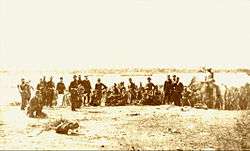



- Brazilian Independence War;
- Battle of Pirajá
- Battle of Jenipapo – Confrontation between the Brazilian Army and against Portuguese Royal Army at riverbanks Jenipapo, Piauí.
- Siege of Salvador – Battle which lead to surrender of Portuguese colonial forces at Salvador, Bahia; Brazilian Independence War.
- Siege of Caxias – Battle which outcome marked the beginning collapse of the Portuguese forces in Maranhão.
- Siege of Montevideo (1823–24)
- Cisplatine War;
- Battle of Ituzaingó – Pitched battle between imperial (Brazilian) and republican (Argentine) forces near Santa Maria River.
- Revolts of Regency period;
- Battle of Detrás-da-Serra (BackMountain) – August 1840. Decisive battle during Balaiada revolt.
- Battle of Porongos – November 1844. Last Battle at Ragamuffin War.
- Platine War;
- Battle of Caseros – Battle involving Brazilian imperial forces at Caseros, Buenos Aires.
- Uruguayan War;
- Siege of Paysandú – Brazilian attack and siege against the fortress of Paysandu.
- Paraguayan War;
- Battle of Yatay - Was the first major land battle of the Paraguayan war, and most important of the war's second phase (August 17, 1865).
- Battle of Estero Bellaco - This battle took place on 2 May 1866, in which the Allied army repulsed a surprise Paraguayan attack.
- Battle of Tuyutí – The largest and bloodiest battle occurred in South American history.
- Battle of Tatayibá – The battle was a cavalry engagement between a Paraguayan force led by General Bernardino Caballero and a Brazilian force led by the Duke of Caxias.
- Battle of Ytororó – Brazilian forces advanced against Paraguayan positions for control of river bridge Ytororó.
- Battle of Avay – Confrontation between Brazilian and Paraguayan forces in stream Avay.
- Battle of Lomas Valentinas – The battle was fought in the Central Department of Paraguay on December 21–27, 1868. The Paraguayan Army, led personally by President Francisco Solano Lopez, were decisively defeated, though he managed to escape.
- Battle of Piribebuy – Confrontation on August 12, 1869 in the Paraguayan town of Piribebuy, which was then serving as a temporary capital of the Paraguayan government, the battle lasted 5 hours, with the Brazilian troops, who had overwhelming numerical advantage, capturing the town.
- Battle of Acosta Ñu – Brazilian troops against Paraguayan forces in Eusebio Ayala, Paraguay.
- Battle of Cerro Corá – Brazilian Army final assault against Paraguayan forces in banks of the Aquidabán River, Paraguay.
Republic:
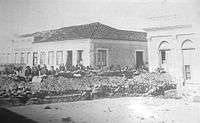
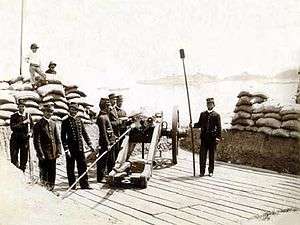
- Second Naval Revolt
- Battle of Guanabara Bay – Army' troops resist to the bombing of rebel warships, as well as defeat the rebels at ground.
- Battle of Armação/Niterói – Requiring support point on land, the rebels decided to occupy the city of Niterói, troops of the army manages to repel the attack, 9 Feb. 1894.
- Federalist Revolution
- The Siege of Lapa – Loyalist troops withstand a siege done by rebels' forces for 26 days, until the arrival of reinforcements, at Curitiba. Jan./Feb., 1894.
- Battle of Carovi – Loyalist troops defeated the rebels, one day after killing the rebel leader, August 10–11, 1895.
- Canudos War;

- 1st Battle at Canudos (3rd Expedition) – Mar. 2–4 1897. Messianic guerrillas defeat the first Expedition carried out by Army, killing its commander.
- Last Battle of Fazenda Velha (Old Farm) – Army's bayonet charge, covered by machine gun fire, imposes decisive defeat over Messianic guerrillas, Sep. 7 1897.
- Battle of Estrada de várzea da Ema (Emu's floodplain Road) – Army troops close the siege on the city of Canudos, making the situation untenable for rebels' remaining forces (from then completely encircled), Sep. 23, 1897.
- Contestado War;
- Battle of Santa Maria – Feb./Apr. 1915; Messianic guerrillas defeated by Army troops in the last major confrontation occurred in Contestado War.
- World War I;
- Hundred Days Offensive – Final series of battles at Western Front, of which the Brazilians military who were sent in mission to France in 1918, participated attached into allied units.
- 1920s Lieutenants Revolts;
- Battle of São Paulo – July 1924; After about three weeks of fighting, rebel troops manage to escape of the siege done by loyalist troops, in a pattern that would be repeated throughout the country until February 1927.
- Battle of Óbidos – Army recovers fortification taken by mutineers, large number of rebel casualties, 25/August. 1924.
- Constitutionalist Revolt;
- Battle of Mantiqueira Tunnel – Jul./Sep. 1932; in the decisive ground combat of that conflit, National Army troops defeat the insurgent forces of São Paulo State.
- World War II;
- Gothic Line, Italian Campaign penultimate phase (one of the longest in WWII):
- Battle of Monte Castello – The battle in which the Brazilian Infantry Division sent to Italian campaign during WWII, were longer involved (about 3 months).
- Battle of Castelnuevo - 1945 March, 5-6.
- Gothic Line, Italian Campaign penultimate phase (one of the longest in WWII):
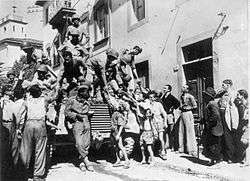

- Final Allied Offensive in Italy: Was the Allied final attack which started on 6 April 1945 and ended on 2 May with the surrender of German forces in Italy.
- Battle of Montese – The bloodiest ground combat for Brazilians in WWII (1945 April, 14–16).
- Battle of Collecchio-Fornovo – The last battle with allied spring offensive in Italy involving large military units, Brazilian troops captured two German divisions Wehrmacht and a division of the Italian Fascist Army,the only time before the end of the war in Italy, where two entire German divisions were captured (1945, April 26–29).
- Final Allied Offensive in Italy: Was the Allied final attack which started on 6 April 1945 and ended on 2 May with the surrender of German forces in Italy.
- Cold War;
- Battle of Santo Domingo – May/Aug. 1965. Part of epochal Brazilian military support to U.S. intervention at Dominican Civil War.
- Araguaia Guerrilla:
- Operação Papagaio (Parrot Operation) – Apr./Oct. 1972; Making conventional use of regular troops, the Army' first campaign against a rural leftist guerrilla, which fought against the then military dictatorship. Inconclusive outcome.
- Marajoara Operation – Oct. 1973/Oct. 1974 – Eradication of rural guerrilla warfare in the Araguaia region, carried out by Army small units, specialized in contra-insurgency.
Today
Personnel

The Brazilian Army had a recorded personnel strength of 219,585 active personnel in 2014.[2] Another estimate by the IISS in 2014 put that figure at 190,000 active personnel, with 70,000 of those being conscripts.[1] In addition there were approximately 1,340,000 reserve personnel in 2014.[1] This figure was down from 1,800,000 reserve personnel in 2008.[41] In principle, the Brazilian Constitution designates the 400,000-strong Brazilian Military Police as a reserve force of the Army, although in practice they remain separate entities.
Conscription
_(24544135452).jpg)
According to Article 143 of the 1988 Brazilian Constitution, military service is mandatory for men, but conscientious objection is allowed. Women and clergymen are exempt from compulsory military service. At the year that they complete age eighteen, men are required to register for the draft and are expected to serve when they reach age nineteen. About 75 percent of those registering receive deferments. A growing number of recruits are volunteers, accounting for about one-third of the total. Those who serve generally spend one year of regular enlistment at an army garrison near their home. Some are allowed nine-month service terms but are expected to complete high school at the same time. These are called "Tiros de Guerra" or "shooting schools", which are for high school boys in medium-sized interior towns, run by Army senior NCO, First Sergeants or Sublieutenants, and rarely a Second Lieutenant. In Brazilian Armed Forces, First Sergeants may be promoted to the Officers Rank, as Second Lieutenant, First Lieutenant and Captain, becoming part of the Auxiliary Officers Corps. The army is the only service with a large number of conscripts; the navy and air force have very few.
The conscript system is primarily a means of providing basic military training to a sizable group of young men who then return to civilian life and are retained on the reserve rolls until age forty-five. The army recognizes that it provides a public service by teaching large numbers of conscripts basic skills that can be valuable to the overall economy when the young men return to civilian life.
Officer Recruitment

.jpg)
Because the only entry into the regular officer corps is the Academia Militar das Agulhas Negras – Military Academy of the Black Needles (AMAN), its records provide an accurate picture of the officer corps. In the decades following World War II, cadets from middle-class families increased, while those from upper-class and unskilled lower-class families declined. The total number of applicants also declined as a result of economic development diversification, which gave high school graduates more attractive options than entering the military. Increasingly, AMAN cadets came from among the graduates of the army-supported Military Schools, which sons of military personnel attended tuition free. Many of these students were sons of NCOs whose own origins were not middle class, so a form of intra-institutional, upward mobility existed.
The trend in the 1960s to recruit from civilian sources has abated. The mental, health, and physical aptitude tests excluded large numbers of civilian school graduates: in 1977 of 1,145 civilians attempting the tests, only thirty-four, or 3 percent, were admitted. In 1985 only 174, or 11 percent, of the AMAN's 1,555 cadets were graduates of civilian schools; the rest were from the army's Military School system, the Cadet Preparatory School (Escola Preparatória de Cadetes—EPC), or air force or navy secondary schools. In the early 1990s, AMAN cadets were drawn exclusively from those who had completed the EPC. By the mid-1990s, the AMAN's cadet population was about 3,000.
In the twentieth century, the officer corps has been composed predominantly of men from the Southeast and South of Brazil, where military units and greater educational opportunities have been concentrated. In 1901–02 the Northeast contributed 38 percent of students at the army's preparatory school in Realengo, whereas in 1982 it provided only 13 percent to the preparatory school in Campinas. In the same years, the Southeast supplied 40.4 percent and 77 percent, while the South gave 8.6 percent and 6.3 percent. Although São Paulo, according to Alfred Stepan and other observers, has not been noted for sending its young men into the officer corps, its contribution increased from 4.3 percent of students in 1901–02 to 33.5 percent in 1982. Regional origins of cadets at the AMAN were fairly consistent in the 1964–85 period. By far the largest contingent came from the state and city of Rio de Janeiro.
Although social theorists might be pleased with indications that the army is serving as a vehicle for social mobility, army leaders are concerned. Officers have remarked on the trend toward lower-class recruitment in the Training Center for Reserve Officers (Centro de Preparação de Oficiais da Reserva—CPOR) and the problems associated with such officers. In a 1986 interview, the former minister of army, General Leônidas Pires Gonçalves, observed that he did not want officers who would give only five or ten years to the army; he wanted individuals with a military vocation, who would stay for a full thirty-plus-year career. Many officers have expressed concern that those seeking to use the army to improve their status are not sufficiently dedicated to the institution. Indeed, some officers seek the earliest possible retirement in order to get a second job (second salary) to make ends meet.
Women in the Army
Women did not participate in Brazil's armed forces until the early 1980s. The Brazilian Army became the first army in South America to accept women into the permanent and career ranks. In 1992, for example, 2,700 women out of 5,000 candidates competed for 136 positions within the Officer's Complementary Corps (Quadro Complementar de Oficiais—QCO).
To begin a career with the army, women must have completed a bachelor's degree in areas such as law, computer science, economics, or accounting. The competition is national in scope, and no applicant may be more than thirty-six years of age. Those accepted into the program study at the Army's School of Complementary Formation (former Army's School of Administration) in Salvador, beginning as first lieutenants (reserve). The School of Complementary Formation is also open to men. At the end of the one-year course, the graduate is promoted to first lieutenant in the permanent ranks.
Organization, formations and structure

High Command

- Army General Headquarters (Quartel-General do Exército) – Brasília
- Land Operations Command (Comando de Operações Terrestres) – Brasília
- Army General Staff (Estado Maior do Exército) – Brasília
Military Commands
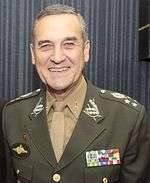
The Army is structured into eight military commands. Each of the eight military commands is responsible for one or more military regions.
-
 Eastern Military Command (Comando Militar do Leste; CML), (HQ: Rio de Janeiro) – 1st and 4th Military Regions
Eastern Military Command (Comando Militar do Leste; CML), (HQ: Rio de Janeiro) – 1st and 4th Military Regions -
 Southeastern Military Command (Comando Militar do Sudeste; CMSE), (HQ: São Paulo) – 2nd Military Region
Southeastern Military Command (Comando Militar do Sudeste; CMSE), (HQ: São Paulo) – 2nd Military Region -
 Southern Military Command (Comando Militar do Sul; CMS), (HQ: Porto Alegre) – 3rd and 5th Military Regions
Southern Military Command (Comando Militar do Sul; CMS), (HQ: Porto Alegre) – 3rd and 5th Military Regions -
 Northeastern Military Command (Comando Militar do Nordeste; CMN), (HQ: Recife) – 6th, 7th and 10th Military Regions
Northeastern Military Command (Comando Militar do Nordeste; CMN), (HQ: Recife) – 6th, 7th and 10th Military Regions -
 Western Military Command (Comando Militar do Oeste; CMO), (HQ: Campo Grande) – 9th Military Region
Western Military Command (Comando Militar do Oeste; CMO), (HQ: Campo Grande) – 9th Military Region -
 North Military Command (Comando Militar do Norte; CMN), (HQ: Belém) – 8th Military Region
North Military Command (Comando Militar do Norte; CMN), (HQ: Belém) – 8th Military Region -
 Amazon Military Command (Comando Militar da Amazônia; CMA), (HQ: Manaus) – 12th Military Region
Amazon Military Command (Comando Militar da Amazônia; CMA), (HQ: Manaus) – 12th Military Region -
 Planalto Military Command (Comando Militar da Planalto; CMP), (HQ: Brasília) – 11th Military Region
Planalto Military Command (Comando Militar da Planalto; CMP), (HQ: Brasília) – 11th Military Region
Military Regions (Divisions)

.jpg)
The Brazilian territory is further divided into twelve military regions. Each military region has the duty of offering logistical support to the Army Divisions (Divisões de Exército), which are those whose role is more operational and linked to the combat itself. Therefore, Military Regions are usually composed of units responsible for providing administration, logistics, transport, health and education as well as anything else the Army Divisions require. On the other hand, the Army Divisions are composed by operational, front line units who will actually fight. Both Army Divisions and Military Regions are Division-sized units, commanded by Lieutenant Generals (Generais de Divisão). Those are the current Military Regions:
-

 1st Military Region (1st Army Division) – States of Rio de Janeiro and Espírito Santo (HQ: Rio de Janeiro)
1st Military Region (1st Army Division) – States of Rio de Janeiro and Espírito Santo (HQ: Rio de Janeiro) -

 2nd Military Region (2nd Army Division) – State of São Paulo (HQ: São Paulo)
2nd Military Region (2nd Army Division) – State of São Paulo (HQ: São Paulo) -

 3rd Military Region (3rd Army Division)– State of Rio Grande do Sul (HQ: Porto Alegre)
3rd Military Region (3rd Army Division)– State of Rio Grande do Sul (HQ: Porto Alegre) -
 4th Military Region (4th Army Division)– State of Minas Gerais (HQ: Belo Horizonte)
4th Military Region (4th Army Division)– State of Minas Gerais (HQ: Belo Horizonte) -
 5th Military Region (5th Army Division) – States of Paraná and Santa Catarina (HQ: Curitiba)
5th Military Region (5th Army Division) – States of Paraná and Santa Catarina (HQ: Curitiba) -

 6th Military Region (6th Army Division) – States of Bahia and Sergipe (HQ: Salvador)
6th Military Region (6th Army Division) – States of Bahia and Sergipe (HQ: Salvador) -
 7th Military Region (7th Army Division)– States of Rio Grande do Norte, Paraíba, Pernambuco and Alagoas (HQ: Recife)
7th Military Region (7th Army Division)– States of Rio Grande do Norte, Paraíba, Pernambuco and Alagoas (HQ: Recife) -
 8th Military Region (8th Army Division) – States of Maranhão, Pará and Amapá (HQ: Belém)
8th Military Region (8th Army Division) – States of Maranhão, Pará and Amapá (HQ: Belém) -
9th Military Region (9th Army Division)– States of Mato Grosso and Mato Grosso do Sul (HQ: Campo Grande)
-
 10th Military Region (10th Army Division) – States of Ceará and Piauí (HQ: Fortaleza)
10th Military Region (10th Army Division) – States of Ceará and Piauí (HQ: Fortaleza) -
 11th Military Region (11th Army Division) – States of Goiás, Tocantins and the Federal District (HQ: Brasília)
11th Military Region (11th Army Division) – States of Goiás, Tocantins and the Federal District (HQ: Brasília) -
 12th Military Region (12h Army Division)– States of Amazonas, Acre, Roraima and Rondônia (HQ: Manaus)
12th Military Region (12h Army Division)– States of Amazonas, Acre, Roraima and Rondônia (HQ: Manaus)
Main units
- 1x Parachute Infantry Brigade, with:
- 3x Parachute Infantry Battalions
- 1x Parachute Cavalry Squadron.
- 1x Special Operations Brigade, with:
- 1x Special Forces Battalion, with 12 SF detachments
- 1x Commando Battalion
- 1x Psychological Operations Battalion.
- 1x Light Infantry (Air Assault) (Airmobile) Brigade, with:
- 3x Light Infantry Airborne Battalions
- 1x Light Cavalry Airborne Regiment (Battalion sized).
- 1x Light Infantry Brigade, with:
- 3x Light Infantry Battalions
- 1x Mechanized Cavalry (Wheeled) Regiment (Battalion size).
- 1x Frontier Infantry (Wetlands Infantry) Brigade, with:
- 3x Frontier Infantry Battalions.
- 2x Armoured Cavalry Brigades, each with:
- 2x Armored Cavalry Regiments (Battalions size)
- 2x Armoured Infantry Battalions
- 1x Mechanized Cavalry (Wheeled) Squadron.
- 4x Mechanized Cavalry (Wheeled) Brigades, each with:
- 3x Mechanized Cavalry Regiments (Battalions size)
- 1x Armoured Cavalry Regiment (Battalion size).
- 6x Jungle Infantry Brigades, each with:
- 3 – 4 Jungle Infantry Battalions
- 1x Mechanized or Jungle Cavalry Squadron.
- 5x Light Infantry (Motorized) Brigades, each with:
- 3x Motorized Infantry Battalions
- 1x Mechanized Cavalry Squadron.
- 4x Mechanized Infantry (Wheeled) Brigades, each with:
- 3x Mechanised Infantry Battalions
- 1x Mechanized Cavalry Squadron.
- 1x Mountain Infantry Light (Motorized) Brigades, each with:
- 3x Mountain Infantry Battalions
- 1x Mechanized Cavalry Squadron.
- 4x Divisional Artillery Brigades, each with:
- 3 – 5 Field or Rocket Artillery Battalions (Agrupements, in Brazilian Army).
- 4x Construction Engineer Brigades, each one with:
- 3x to 5x Construction Engineer Battalions
- 1x Mechanized Cavalry Squadron.
- 2x Air Defence Artillery Brigade, with:
- 5x Anti-aircraft Artillery Battalion
- 1x Army Aviation Command(Brigade), with:
- 4x Army Aviation Battalions (Anti-tank, reconnaissance, multi-purpose, transport, utility).
Strategic Mobile Action Forces
 Airborne Brigade
Airborne Brigade
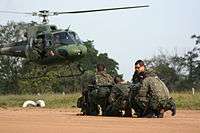
.jpg)
The 12th Infantry Airborne Brigade is a major elite unit of the Brazilian Army. Headquartered in Caçapava in São Paulo. Its operation area covers the whole country. It is under the 2nd Army Division / Southeastern Military Command, based in São Paulo.
It is organized, equipped and trained for rapid-response missions at any point of the country. They can move by air using business jets and civilian aircraft, but their primary means of transportation are the Brazilian Air Force's rotorcraft, from the Command Army Aviation, usually based near their barracks. By performing their main function, the airborne assault, the Light Brigade constitutes an effective, permanently available instrument of strategic reach, being an integral unit of the Strategic Task Force (Força de Ação Rápida Estratégica)of the Brazilian Army.[42]
 Army Aviation Brigade
Army Aviation Brigade
.jpg)

The Army Aviation Command, also known as Ricardo Kirk Brigade, is a brigade of the Brazilian Army, located in Taubaté and linked to the Land Operations Command and the Southeastern Military Command. Its historical name is a reference to Captain Ricardo Kirk, pioneer of military aviation in Brazil, killed in battle in the Contestado War.
The task of the Brazilian Army Aviation Command is to provide organic airmobility and support the ground forces by providing tactical air support, close air support and reconnaissance.[42]
 Law and Order Operations Brigade
Law and Order Operations Brigade
.jpg)
The 11th Infantry Brigade is one of the brigades operating in the Brazilian Army. Its headquarters is located in Campinas, São Paulo.
This infantry brigade is specialized in operations in urban terrain, being able to act in cases of severe instability or danger to public order. The brigade is used in Brazil often in actions against organized crime and drug trafficking, especially in large urban centers.
It is trained to operate both in case of riots and in the fight against organized crime and drug trafficking, when the local law enforcement agencies are unable to do so by themselves. Recently it has operated alongside other elite Army forces in the pacification of communities that were previously under control of drug traffickers in Rio de Janeiro.[42]
 Jungle Warfare Brigades
Jungle Warfare Brigades
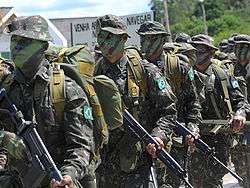
.jpg)
The Jungle Warfare Training Centre – Centro de Instrução de Guerra na Selva (CIGS), also known as the Colonel Jorge Teixeira Centre, is a military organisation based in Manaus, intended to qualify military leaders of small groups, as wilderness warriors, fighters able to accomplish military nature missions in the most inhospitable areas of the Brazilian rainforest.
Courses are taught in jungle operations scenery in different categories – Senior Officers, Officers, Senior Non-Commissioned Officers, Non-Commissioned Officers, Medical and Health Care Personnel, and small courses for the military, police forces and civilians. Its symbol is the jaguar.
The Jungle Warfare Training Center (CIGS) is structured as Department of Education, a Department of Doctrine and Research, a Student Division, a Department of Veterinary Medicine, a Department of Administration and a Support Company.[43]
Although officers and NCOs from all over Brazil can apply to take courses at CIGS, most of the troopers that support training are locals, natives from the area are that are mainly privates and corporals. Because they are adapted to the conditions of the life inside the forest, they are more capable of performing a vast array of activities, such as hunting, hiding and moving through the forest with ease. Many foreigners and Brazilian military personnel that underwent training at CIGS have described the impressive abilities shown by these soldiers during operations. Their experience and skills in jungle survival certainly help shaping the Brazilian Jungle Warfare Brigades into deadliest units of its kind in the world.
The Brigades also have experience in combat. Engaged in protecting the Northern borders of Brazil, the troops are constantly exposed to attacks from border countries guerrillas, drug dealers and criminals of all kinds. The Brazilian Army commonly acts along with other law enforcement organisations in order to fight not only the drugs trafficking, but also animals, weapons, people and several other illegal deeds.
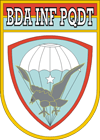 Paratroopers Brigade
Paratroopers Brigade

.jpg)
The Paratroopers Brigade is a major elite units of the Brazilian Army. Its headquarters is located in Vila Militar, in the city of Rio de Janeiro. Subordinate to the Eastern Military Command, based in Rio de Janeiro, in conjunction with the Land Operations Command, based in Brasilia.
The Brigade Parachute Infantry is one of the elite troops of the Brazilian Army. Ready to jump and operate behind enemy lines. Is prepared to act on within 48 hours anywhere in the country, is in the jungle, savanna, marsh and mountain, and remain without logistical support for up to 72 hours. After completion of the mission, handing territory to another conventional unit to maintain the position gained, according to the doctrine of the Brazilian Army training, usually a unit or a brigade of armoured Infantry will be responsible for replacing the Paratrooper Brigade field after the transfer of the territory to another unit of the Ground Force, the Paratrooper Brigade is then thrown back behind enemy lines once more to make way for the Allied troops.
The Brigade Parachute Infantry is a fundamental part of the Strategic Task Force (Força de Ação Rápida Estratégica), by being able to quickly operate in any part of the national territory in case of war or invasion.
Due to the deadly and dangerous nature of this brigades' missions, the Brazilian paratroopers have a unique ethos. For instance, while regular infantry troops use black boots and green berets, the paratroopers use brown boots and red berets. They consider themselves superior to the "Pé pretos" (black foots), which are the regular infantrymen. The Brazilian Army's motto, "Brasil acima de tudo!" (Brazil, above everything else) was originally the paratroopers warcry before it was popularized (nowadays it's a common greeting between the military to say this motto). The paratroopers are very proud of themselves, and they are always stand out when they are among other troops.[44]
 Special Forces Brigade
Special Forces Brigade

._(7945391348).jpg)
The Special Operations Brigade is Brazil's special operations force. Although administratively assigned to the Plateau Military Command, the brigade's operations are under the direct control of the Land Operations Command.[45] The Special Forces were initially formed in 1957 as a parachute trained rescue unit, which specialized in conducting deep jungle rescues along the Amazon basin. After conducting its initial selection, a US Army Special Forces Mobile Training Team (MTT) conducted the unit's first training course.[46]
Nowadays, it is specialized in non conventional warfare, performing psychological operations and harassing bigger enemy units, such as Brigades and Divisions. Acting in smalls cells and detachments (usually no more than 20 men), the Special Forces act deep behind enemy lines, and are capable of fighting in extremely unfavorable situations.
Its motto "any mission, in any place, at any time, by every way" tells all. Related Commandos troops, a battalion size of Special Operations Brigade has an anlogous motto,that is "The maximum confusion, death and destruction in the deep rear of the enemy".
It is also capable of performing other types of missions, such as counter-terrorism, strategic scouting, finding and attacking high-value targets and stealing, extracting and evading. Due to the extremely high level of danger of those missions, this unit is composed of only a few members, who must have completed the Comandos and Paraquedista (Commandos and Paratroopers). They are highly specialized and ready to operate anywhere in the world in less than 45 hours. Because of this, they are recognized as one of the most prestigious units in the Brazilian Army
 Mountain Operations Brigade
Mountain Operations Brigade
.jpg)
It's a specialized infantry brigade of the Brazilian Army. Its headquarters is located in Juiz de Fora, Minas Gerais. Its catchment area covers the state of Minas Gerais and Petropolis. It is administered by the 1st Army Division / Eastern Military Command, headquartered in Rio de Janeiro.
4th Mountain Infantry Brigade is a unit of the Brazilian Army, specializing in mountain combat operation, improving and developing special techniques of mountain operations and using equipment and weapons specific to this theater of operations, has established itself over the years as an elite troop, and even multiplying their special techniques to other Brazilian military units, which will attend their courses and internships, assists the training of the units members of the Strategic Task Force (Força de Ação Rápida Estratégica)of the Brazilian Army.
During the II World War the Brazilian infantry had major highlight in the conquest of the town of Montese situated in mountainous terrain and heavily defended by the Germans as the last bastion stop the advancing allied troops toward the Po Valley. On April 14, 1945, the massive Montese became the scene of the most arduous and bloody battle of Brazilian arms in Italy, in the words of their own Commander Brazilian Expeditionary Force Marechal Mascarenhas de Morais. Having eleven main effort of the attack as fighting in dense minefields and under heavy fire from German machine guns, they were finally able to conquer Montese.
 Fast Motorized Operations Brigade
Fast Motorized Operations Brigade
The 3rd Mechanized Infantry Brigade, also known as the Viscount of Porto Seguro's Own Brigade, is one of the Brigades of the Brazilian Army. Its headquarters is located in Crystal, in Goiás State. It is subject to the Planalto Military Command, with headquarters in Brasilia. Its subordinate military organizations are located in the Federal District and the states of Goiás, Tocantins and Minas Gerais region known as Triangulo Mineiro. Its historic name is a tribute to the Viscount of Porto Seguro, Francisco Adolfo Varnhagem.
The 3rd Brigade is part of the strategic reserve of the Brazilian Army, but should be able to be employed at any time and in any part of Brazil. Being a mechanized formation, it can be deployed fast enough anywhere nationwide either for conventional operations or to reinforce the military police in keeping public order, and can still perform promptly any motorized, airmobile or airborne action.
Battalions and Regiments specialized
1st Chemical, Biological, Radiological and Nuclear Defense Battalion
.jpg)
.jpg)
The 1st Chemical, Biological, Radiological and Nuclear Defesne Battalion, raised in 2012 by the redesignation of the Army CBRN Defense Company, is the only one of its kind in the Brazilian Army, and its members are trained for combat in chemical, biological and nuclear warfare (as the name suggests), mainly in control and decontamination of weapons, local and military equipment.
The battalion's origin dates back to 1953, when the Chemical Warfare Company, originally subject to the Reverse Split Units-School (RSUS) was set up on the premises of the Special Education School (SES)
On December 31, 1987, the Chemical Warfare School was extinguished and, in its place, the CBRN Company was created, based in the city of Rio de Janeiro and subordinated to the Board of Specialization and Extension.
 17th Border Battalion (Swamp Operations )
17th Border Battalion (Swamp Operations )
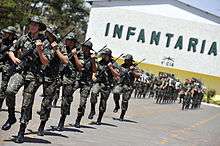
The 17th BB is an elite unit of the Brazilian Army, specializing in swamp operations that is located in the city of Corumbá, state of Mato Grosso do Sul.
Its main missions, ensuring the western border of Brazil, the development and improvement of technical and operational doctrines and special combat specific swampy environment (present in many places in the world) and also multiply its technical operations in wetland units members Strategic Task Force (Força de Ação Rápida Estratégica)of the Brazilian Army, but specifically, offering a course of Wetland Operations (Operações no Pantanal) to the Special Operations Brigade, Parachute Infantry Brigade and the 12th Light Infantry Brigade (airbone), units within the Strategic Task Force, and also military from other regions, particularly the Western Military Command, which is responsible for the protection of the western border of the Brazilian territory. Besides that, there are also exchanges of techniques and experiences with the Brazilian Marines, which also apply to the Wetland Operations course and are remarkably skilled in anphibious operations.
 72nd Motorized Infantry Battalion (Caatinga/Savanna Operations)
72nd Motorized Infantry Battalion (Caatinga/Savanna Operations)
.jpg)
The 72nd MIB is an elite unit of the Brazilian Army based in Petrolina, being the only unit of the Brazilian Army to train the warfighter to the operating environment of Caatinga and Savanna.
Has a Caatinga Operations Instructions Center, covering an area of approximately 28,000 km ².
The facilities of the Caatinga Operations Instructions Center are comprised in an area which belongs to the Ministry of Defence, named the Field Instruction Iron Tank Farm, responsible for the formation of the Caatinga battle combatant in this environment. The vegetation is aggressive and thorny, the sun is very harsh for most of the daytime and water is sparse. The conditions of this area are very difficult to withstand and soldiers who finish this course are acknowledged as Caatinga Warriors of the Brazilian Army, as described by the Brazilian Army in its website(in Portuguese).[47]
 Presidential Guard
Presidential Guard

The Presidential Guard Battalion is a unit of the Brazilian Army and honor guard to the President of Brazil. Two other units, the 1st Guards Cavalry Regiment and the Cayenne Battery, are also part of the presidential honor guard unit, and they all report to Army HQ.
The PGB had its origins in the Emperor’s Battalion, organized in 1823 during the peace campaigns that followed the Declaration of Independence as the guards unit for the Imperial Family of Brazil, and as such wears its 19th-century uniforms. Disbanded in 1827, it was reformed in 1933.
.jpg)
The 1st Guards Cavalry Regiment also known as the "Dragões da Independência" (Independence Dragoons), is the squadron-sized horse guards regiment of the Army. The name was given in 1927 and refers to the fact that a detachment of dragoons escorted the Prince Royal of Portugal, Pedro VI, at the time when he declared Brazilian independence from Portugal, on September 7, 1822. The Independence Dragoons wear 19th century uniforms similar to those of the earlier Imperial Honor Guard, which are used as the regimental full dress uniform since 1927. The uniform was designed by Debret, in white and red, with plumed bronze helmets. The colors and pattern were influenced by the Austrian dragoons of the period, as the Brazilian Empress Consort was also an Austrian Archduchess. The color of the plumes varies according to rank. The Independence Dragoons are armed with lances and sabres, the latter only for the officers and the colour guard.
The regiment was established in 1808 by the Prince Regent and future king of Portugal, John VI, with the duty of protecting the Portuguese royal family, which had sought refuge in Brazil during the Napoleonic wars. However dragoons had existed in Portugal since at least the early 18th century and, in 1719, units of this type of cavalry were sent to Brazil, initially to escort shipments of gold and diamonds and to guard the Viceroy who resided in Rio de Janeiro (1st Cavalry Regiment – Vice-Roy's Horse Guard Squadron). Later, they were also sent to the south to serve against the Spanish during frontier clashes. After the proclamation of Brazilian independence, the title of the regiment was changed to that of the Imperial Honor Guard, with the role of protecting the Imperial Family. The Guard was later disbanded by Emperor Pedro II and would be recreated only later in the republican era, this time as the horse guards unit mandated to defend and protect the President of Brazil and his First Family, the Vice President of Brazil and all offices of the national government. At the time of the Republic proclamation in 1889, horse #6 of the Imperial Honor Guard was ridden by the officer making the declaration, Second Lieutenant Eduardo José Barbosa, with the permission of Field Marshal Deodoro da Fonseca. This is commemorated by the custom under which the horse having this number is used only by the commander of the modern regiment, usually a superior officer with the rank of a Lieutenant Colonel.
The regiment maintains its own band, which also serves as the official presidential band.
 Army Police Battalions and Platoons
Army Police Battalions and Platoons
See article: Army Police (Brazil)
_sob_nova_dire%C3%A7%C3%A3o_(14167662998).jpg)
The Army Police Branch is composed of specialized units of the Brazilian Army Infantry, who develop the mission of military police along the headquarters of major commands and major units of Land Force garrisons.
As operating units of the Army Police, there are several battalions, companies and platoons. Military Police of the Brazilian Army are identified by the use of black armband with the letters "PE" in white (or white armband with red letters).
Current Equipment
- Main battle tanks – 469 (M60 Patton, Leopard 1A1 and Leopard 1A5/GR)
- Armored vehicles – 1,496 (AV-VBL 4x4, Cascavel 6x6, Urutu 6x6, Guarani 6x6, M113 and M577)
- Artillery pieces – 1,257 (120mm mortar, ASTROS II, ASTROS 2020, M101, M102, M114, 105mm Mod 56, L118, Oerlikon 35mm and Bofors 40 mm)
- Self-propelled artillery – 184 (M108, M109 and Gepard)
- Surface-to-air missile system - 156 (9K38 Igla and RBS 70)
- Other military vehicles – 20,000 (trucks, light vehicles, buses and boats)
In addition the Brazilian Army Aviation Command operates 90 helicopters.
- Transport helicopters – EC 725 Caracal
- Attack and Observation helicopters – HB350 Esquilo, AS550 Fennec and AS565 Panther
- Multi-mission and rescue helicopters – AS532 Cougar and Sikorsky S-70A
The current equipment of the Brazilian Army in action
-

Leopard 1A1 main battle tank
-
.jpg)
VBTP-MR Guarani armoured personnel carrier
-

EE-9 Cascavel Armoured car
-

EE-11 Urutu Armored personnel carrier
-
.jpg)
AV-VBL light armored vehicle
-
EC 725 Caracal helicopter
-
.jpg)
Brazilian Flakpanzer Gepard
-

AS-532 Cougar helicopter.
-
.jpg)
Brazilian M113 squad
-
.jpg)
Logistical support bridge in Brazilian Army
-
.jpg)
Leopard 1A5 main battle tank
-
.jpg)
ASTROS 2020 multiple rocket launcher in action
-
.jpg)
Bofors 40 mm AA howitzer in action
-
.jpg)
Igla System
-
%2C_onde_ocorreu_a_Opera%C3%A7%C3%A3o_Amaz%C3%B4nia_2012_(8030633896).jpg)
UH-60 Black Hawk in Brazilian Army Aviation.
-
.jpg)
LPR-40 river patrol boat.
-
.jpg)
AS565 Panther helicopter.
-
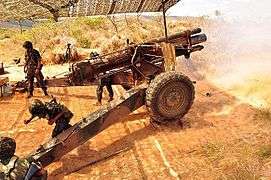
Brazilian M114 howitzer artillery.
-
.jpg)
Guardian patrol boat.
Historical Equipment
Tanks
- Renault FT: 12 units 1921–1944
- L3/35: 24 units 1938–1944
- M3 Stuart A3/A5: 350 units 1942–1978
- M3 Lee: 104 units 1942–1969
- M4 Sherman A1: 85 units 1944–1972
- M41 B/C: 340 units 1960–2010 (100 in storage)
- EE-T1 Osório: 02 prototypes 1982–2004 (in storage)
Armoured vehicle
- Citroën P17: 10 units 1935–1950
- Sd.Kfz.6,7,8: 11 units 1939–1960
- M4 Tractor: ? 1941–1980
- M8 Greyhound: 15 units 1944–1976
- M20 Armoured Car: 20 units 1945–1985
- M3 Scout Car A1: 100 units 1942–1979
- M2 Half Track Car: 437 units 1943–1980
- M3 Half-track: 49 units 1944–1976
- M59 APC: 500 units 1960–1982
Artillery
- Canet guns 100mm: ? 1880–1911
- Hotchkiss gun: ? 1887–1936
- Bofors 75 mm Model 1934: ? 1935–1960
- Krupp 7.5 cm Model 1903: 10 units 1936–1970
- 7.5 cm FK 38: 55 units 1939–1970
- 8.8 cm Flak 18/36/37/41: ~10 units 1939–1960
- BL 6-inch Gun Mk XIX: 116 units 1942–1977
- M116 howitzer: ~100 units 1940–1980
- M3 Gun Motor Carriage: 10 units 1943–1970
- Ordnance QF 25-pounder: ? 1943–1970
- Bethlehem 177: 11 units 1945–1968
- 90 mm Gun M1/M2/M3: ? 1944–1977
- Roland SAM: 04 units 1970–1999
Other vehicles
- Dodge WC: ? 1940–1985
- GMC CCKW: ? 1940–1970
- Willys MB: ~1,000 units 1946–2000
- Dodge M37: ? 1960–1993
- EE-34: ? 1973–2002
-
L3/35 tankette -
FT17 light tank -
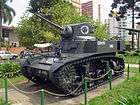
M3 Stuart light tank -
M41 tank -
.jpg)
M3 Lee -

Roland SAM -
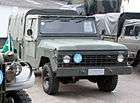
EE-34 pickup -
Railway gun Bethlehem 177
Ranks, uniforms, and insignia
The senior-most commissioned rank in the Brazilian Army is the "General de Exército" (English: General of the Army), a "four-star" general. In times of war, or in exceptional circumstances, a fifth star may be worn by the highest-ranking officer in the army, who is then promoted to "Marechal", (English: Marshal of the Army). Brazilian Army officers wear rank insignia on shoulder boards and the army has ten officer ranks, also known as "grades", excluding that of an officer candidate.
.jpg)

Brazilian Army officer ranks from second lieutenant to colonel equate directly with counterparts in the United States Army, but thereafter the systems diverge. A Brazilian "General de Brigada" (English: brigadier general) wears two stars, with duties equivalent to a U.S. Army brigadier general, the next higher rank, "General de Divisão" (English: divisional general), equivalent to an American major general, wears three; their United States counterparts have only one and two stars, respectively. The next higher rank, designated by four stars, is "General de Exército" (English: General of the Army). The Marshal wears five stars, but that rank is rarely attained on active duty. There is no rank that corresponds to an American lieutenant general.
Brazil's army has strict up-or-out retirement rules, which were developed in the mid-1960s by President Castelo Branco. The internal command structure determines all promotions through the rank of colonel. The president is involved in the promotions to general and chooses one candidate from a list of three names presented to him by the High Command. Once passed over at the Presidential Promotion Board, the non-promotable colonel must retire. All colonels must retire at age fifty-nine and all four-star generals must retire at age sixty-six, or after twelve years as general.
Despite the up-or-out system, under President José Sarney the army became top-heavy as generals began to occupy many positions that previously had been reserved for colonels. In 1991 there were fifteen four-stars, forty three-stars, and 110 two-stars generals. The figure for four-stars generals did not include four who were Ministers in the Superior Military Court (Superior Tribunal Militar—STM). Thus, in the mid-1990s the army sought to reduce the number of active-duty generals. In 2014, there are fifteen four-stars, forty five three-stars, and eighty nine two-stars generals in active service.
The highest Brazilian Army enlisted rank is "Sub Tenente", which is the equivalent of an American command sergeant major and sergeant major ranks. The other NCOs are Primeiro Sargento equivalent of an American first sergeant or master sergeant, "Segundo Sargento" (English: second sergeant) equivalent to a sergeant first class and staff sergeant, Terceiro Sargento equivalent to Sergeant. Then there is the Cabo Corporal with the same duties as a Sergeant in a regular Army Infantry Platoon, acting as the Squad Leader. The Brazilian Army has no corresponding equivalent to the U.S. Army's specialist rank. The "Soldado" is equivalent to a private first class or to a private depending on the length of service time.
Gallery
Historical
-

Brazilian guard (soldier) of the colonial period, 18th century.
-

Uniform of the Brazilian Colonial Army, eighteenth century.
-

Guard (soldier) and captain (officer) of the Imperial Guard of Honor in 1825.
-

Brazilian National Guard officers in 1840.
-
Brazilian army officers during the Platine War (1851-1852).
-

1st Regiment of Light Cavalry in 1852.
-

The Brazilian army in Paraguay (1869).
-

Cavalry regiment of the Brazilian army in 1888.
-

Soldiers of the 4th Battalion of Artillery. Provisional fortification, 1894.
-
General Bellarmine and Brazilian Army troops in 1910.
-

Brazilian Army Aviation in Contestado War.
-

Lt. Ricardo Kirk first Brazilian military aviator and patron of the Brazilian Army Aviation, killed in action in the Contestado War.
-

Brazilian Army officers, 1924.
-

Brazilian Army light infantry, 1930.
-

Brazilian Army camp during the revolution of 1930.
-

Marshal Cândido Rondon explorer of the Amazon region. Patron of the communications units of the Brazilian Army.
-

Army troops and soldiers prisoners paulistas during the Constitutionalist Revolt, 1932.
-
Exercise of coastal artillery in 1975.
Present-day
-

Brazilian soldiers embarking for East Timor
-

Brazilian troops leaving for Haiti.
-

Brazilian Army soldiers, part of the United Nations Stabilization Mission in Haiti, in 2004.
-
.jpg)
Brazilian Army soldiers in the rescue of survivors after the 2010 Haiti earthquake.
-
Bodies of Brazilian soldiers killed in the 2010 Haiti earthquake.
-

Cadets of the Academia Militar das Agulhas Negras.
-
Soldiers paratroopers operating in Rio de Janeiro, 2008.
-

Army soldier on guard in Brasília, 2008
-

Brazilian Army Mechanized Cavalry Squadron in law and order operation, 2012.
-
.jpg)
Brazilian soldier in river operation, 2014.
-
.jpg)
Infantry Army and Marines in training set
-
.jpg)
Garrison (driver and shooter) of an armored vehicle.
-
.jpg)
Brazilian soldiers in law and order operatin.
See also
- Brazilian Naval Aviation
- Brazilian Navy
- Brazilian Army Aviation
- Brazilian Air Force
- Academia Militar das Agulhas Negras
- Units
- Presidential Guard Battalion
- 1st Guards Cavalry Regiment
- Cayenne Battery
- 1º Batalhão de Forcas Especiais
- Armed Forces of the Empire of Brazil
- Generic
References
- 1 2 3 4 International Institute for Strategic Studies (3 Feb 2014). The Military Balance 2014. London: Routledge. pp. 371–375. ISBN 9781857437225.
- 1 2 Decree 8.399, February 4th 2015.
- ↑ Site brasil.gov.br
- 1 2 Pedrosa, p.229
- ↑ Nabuco, p.463
- 1 2 3 4 5 Vainfas, p.548
- ↑ Nabuco, p.58
- ↑ Vianna, p.433
- ↑ Holanda, p.238
- ↑ Souza, p.110
- ↑ Souza, p.113
- 1 2 Vainfas, p.318
- ↑ Holanda, p.243
- ↑ Souza, p.209
- 1 2 Souza, p.205
- 1 2 Holanda, p.244
- ↑ Pedrosa, p.225
- 1 2 Souza, p.208
- ↑ Souza, p.192
- ↑ Vainfas, p.319
- ↑ Pedrosa, p.226
- ↑ Pedrosa, p.227
- ↑ Holanda, p.245
- ↑ Pedrosa, p.207
- 1 2 Vainfas, p.549
- ↑ Vainfas, p.320
- ↑ Doratioto (2002), p.28
- ↑ Pedrosa, p.234
- ↑ Pedrosa, p.235
- ↑ Nabuco, p.503
- ↑ Pedrosa, p.242
- ↑ Pedrosa, p.237
- ↑ Schwarcz, p.303
- ↑ Versen, p.99
- ↑ Salles (1990), p.129
- ↑ Salles (2003), p.38
- ↑ http://www.cbc.ca/news/world/brazil-military-continues-raids-on-slums-before-world-cup-1.2599596
- ↑ http://www1.folha.uol.com.br/esporte/folhanacopa/2014/04/1440021-seguranca-tera-o-maior-efetivo-da-historia-das-copas.shtml
- ↑ http://dialogo-americas.com/en_GB/articles/rmisa/features/2015/10/06/feature-06?change_locale=true
- ↑ http://www.defesanet.com.br/en/defense/noticia/20509/Brazil-Creates-Expeditionary-Force-to-Serve-in-International-Missions/
- ↑ Os pés de barro de um gigante Revista Época. Retrieved on 2009-02-01. (Portuguese)
- 1 2 3 http://www.eb.mil.br/web/guest%3bjsessionid=126DB3C72C16DB4F9E961D0EDEC17535.lr1
- ↑ Jungle Warfare Training Center Brazilian Army, accessed on May 8, 2008. (in Portuguese)
- ↑ http://www.eb.mil.br/
- ↑ Land Operations Command Brazilian Army, accessed on May 8, 2008. (in Portuguese)
- ↑ Special Operations Brigade Brazilian Army, accessed on May 8, 2008. (in Portuguese)
- ↑ http://www.cporr.ensino.eb.br/index.php/atividades/144-estagio-de-adaptacao-a-caatinga
Bibliography
- Celso Castro, Vitor Izecksohn and Hendrik Kraay "Nova História Militar Brasileira" (New Brazilian Military History) (Portuguese) Getúlio Vargas Foundation 2004 ISBN 8522504962
- Christiane Figueiredo Pagano de Mello "Forças Militares no Brasil Colonial" (Military Forces in Colonial Brazil) (Portuguese) E-papers 2009 ISBN 9788576502050
- Dávila, Jerry. "Hotel Tropico: Brazil and the challenge of African Decolonization, 1950–1980." Duke University Press 2010 ISBN 978-0822348559
- Dudley, William Sheldon "Reform and Radicalism in the Brazilian Army, 1870–1889" Columbia University 1972
- Donato, Hernâni "Dicionário das Batalhas Brasileiras" (Dictionary of Brazilian Battles) (Portuguese) IBRASA 1996 (2nd edition ) ISBN 8534800340
- Faoro, Raymundo "Os Donos do Poder" (Owners of Power) (Portuguese) Globo 2012 (1st edition 1958) ISBN 9788525052964
- Fishel, John T. & Sáenz, Andrés "Capacity Building for Peacekeeping; The case of Haiti" NDU Press & Potomac Books 2007 ISBN 9781597971232
- Gaspari, Elio – An amply documented series containing 4 volumes (divided into 2 parts: "The Armed illusions", Volumes I-II, and "The Priest and Warlock", volumes III-IV), about the army and the last military dictatorship in Brazil:
- Volume I "A Ditadura Envergonhada" (The Dictatorship Embarrassed) (Portuguese) ISBN 8535902775
- Volume II "A Ditadura Escancarada" (The Dictatorship Revealed) (Portuguese) ISBN 8535902996
- Volume III "A Ditadura Derrotada" (The Dictatorship Defeated) (Portuguese) ISBN 853590428X and
- Volume IV "A Ditadura Encurralada" (The Dictatorship Trapped) (Portuguese) ISBN 853590509X. All books by Companhia das Letras, 2002–2004
- Guerra, Cláudio "Memórias de uma Guerra Suja" (Memoirs of a Dirty War) (Portuguese) TopBooks 2012 ISBN 8574752045
- Hooker, Terry "The Paraguayan War: Armies of the Nineteenth Century; The Americas" Foundry 2008
- Joes, Anthony James "Urban Guerrilla Warfare" University Press of Kentucky 2007 on Google Books
- Kraay, Hendrik "Race, State and Armmed Forces in Independence-Era Brazil" Stanford University Press 2001 ISBN 0804742480
- Kraay, Hendrick & Whigham, Thomas "I Die with My Country: Perspectives on the Paraguayan War, 1864–1870" University of Nebraska, 2004 ISBN 0803227620
- López, Adriana "Franceses e Tupinambás na Terra do Brasil" (French and Indigenous in land of Brazil) (Portuguese) SENAC 2001 ISBN 857359179X
- McCann, Frank D. "Soldiers of the Patria, A History of the Brazilian Army, 1889–1937" Stanford University Press 2004 ISBN 0804732221
- Mello, Evaldo Cabral de "Olinda restaurada; Guerra e Açúcar no Nordeste, 1630–1654" (Olinda restored: War and Sugar in Northeast Brazil, 1630–1654) (Portuguese) Editora 34 Ltda 2007 (1st edition 1975)
- Smallman, Shawn C. "Fear & Memory: in the Brazilian Army & Society, 1889–1954" University of North Carolina Press 2002 ISBN 0807853593
- Skidmore, Thomas E.:
- "Politics in Brazil 1930–1964: An Experiment in Democracy" Oxford University Press 1967
- "The Politics of Military Rule in Brazil: 1964–85" Oxford University Press 1988
External links
- Official Brazilian Army Website (in Portuguese)
- Official Brazilian Army Aviation Command Website (in Portuguese)
- Base Militar Web Magazine (in Portuguese)
- Information on the Osório MBT (in English)
- Military Orders and Medals from Brazil (in Portuguese)
- Uniforms Brazilian Army 1822-1830 (in Russian)
- Latin American Light Weapons National Inventories (in English)

.jpg)
.jpg)